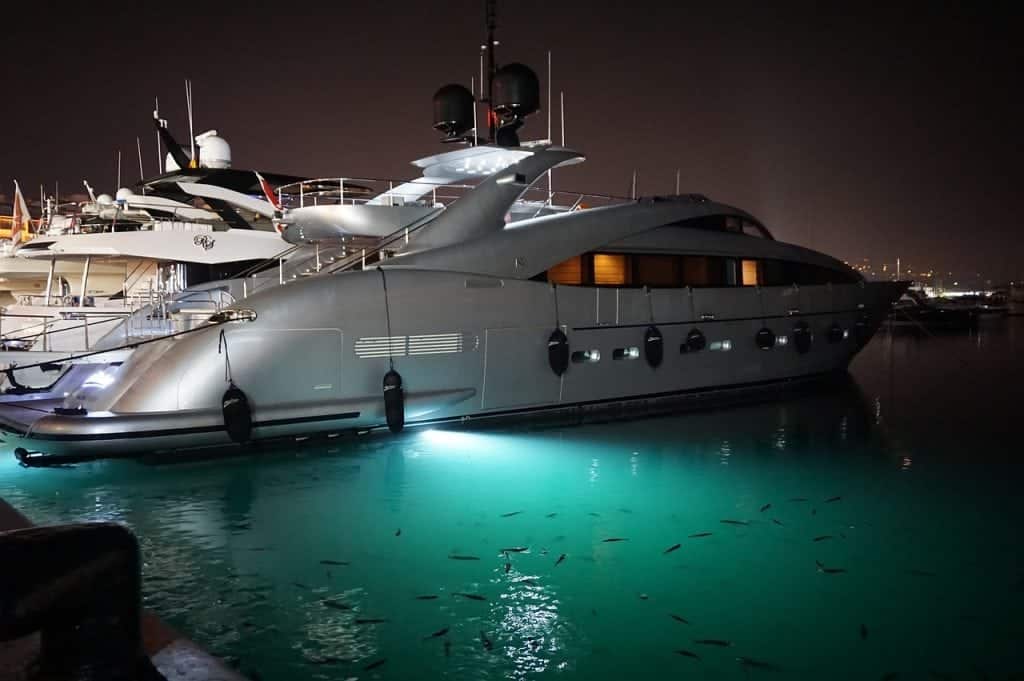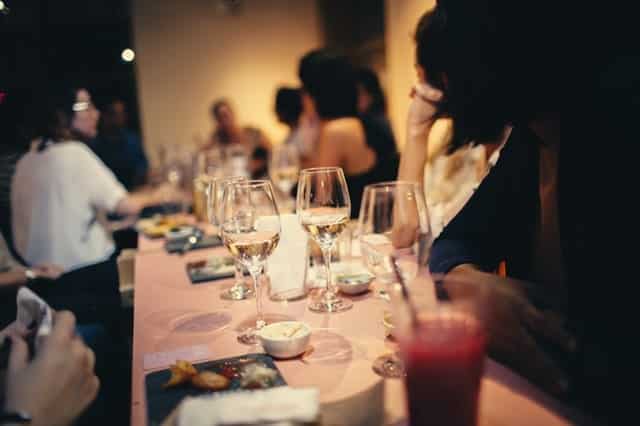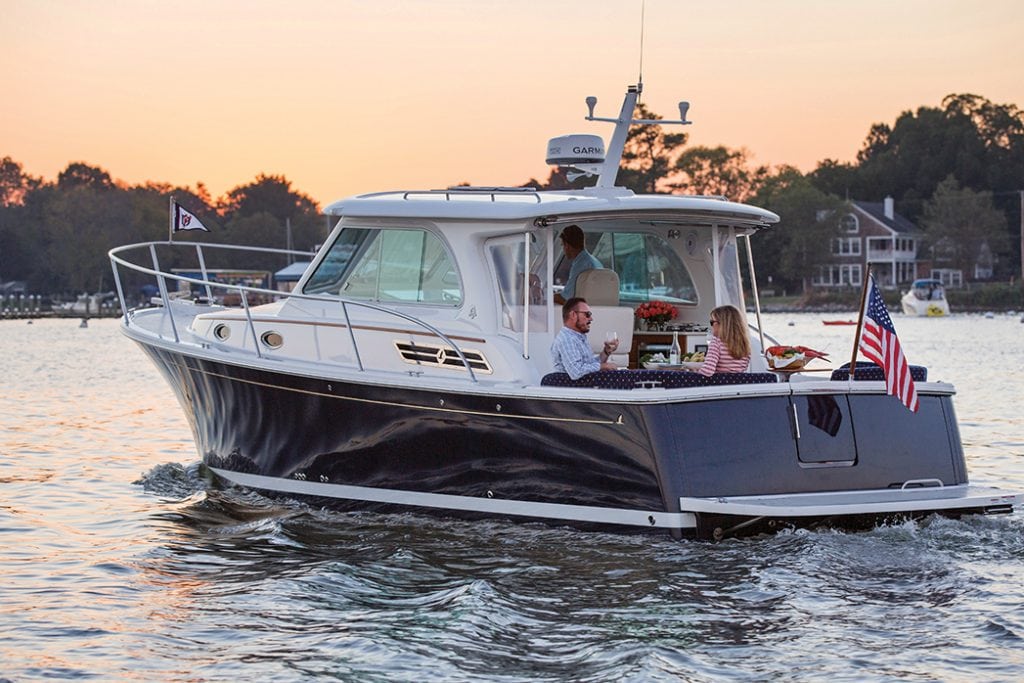Underwater lights synched with music will transform your ho-hum boat into party central.
The best parties have it all: great food and drinks, music and dancing, fun people, and the right mood to tie it all together. Lights that change with the rhythm of music is the icing on the cake. But when you put them underwater on the bottom of your boat, it turns the water—whether you’re at the dock or offshore—into a modern-day disco ball for guests to shimmy to a watery version of Saturday Night Fever. For those less inclined to party, underwater lights can enhance the mood for a quiet evening on the hook.
“Underwater lights can be programmed to change color depending on the type of music you’re playing,” says Alexandra Bader, U.S. vice president of sales and marketing for Aqualuma. “They can pulse or stay stagnant depending on the mood of the evening. Underwater lights like our Gen 4, 18 Series Thru Hull lights can change the atmosphere of any party with a few clicks.”
Dance like everyone’s watching (even the fish)
The earliest versions of programmable underwater lights only offered a few colors. But the range of colors, effects, and features now available have increased dramatically. According to Susan James, marketing director for Lumishore, the company’s EOS Series offers fish strobe, color cycle with adjustable speed and color sweep with adjustable speed that cycles the colors across the boat’s transom or around the entire vessel. “There’s also Sound-to-Light, enabled simply by connecting a single, three-point-five-millimeter stereo jack audio-out cable from your onboard stereo to the EOS controller. There are also adjustments users can make to their Sound-to-Light mode where they can increase or decrease the sensitivity or pulse speed of their lights.”
OceanLED produces a range of underwater lights that are Digital Multiplex (DMX) compatible, which allows a link of the lights to audio entertainment systems to produce exciting lighting effects. “We control the lights using our proprietary smartphone or tablet app,” says Jim Deheer, OceanLED director of marketing. “The app has several modes, one of which is Dynamic Audio Control.” An audio jack plug links the lights’ DMX control box and the audio system. The user then selects the preferred colors for the bass, mid and treble on the app, and the colors change in response to the beat of the music. Once the sound is connected, users can program the lights to their favorite music.
While illuminating your vessel’s bottom has definite safety attributes, such as making the boat more visible to others, and it’s also a powerful way to attract fish. These cutting-edge LED lights also have a lifespan of more than 40,000 hours—25 years if you run them 30 hours a week. LED lights offer a low power draw, fast start-up and nearly unlimited color options.
New Year, New Lights
Replacing or changing the lights has also become much easier. Aqualuma lights are accessible from the inside of the boat and replaced without having to haul out. The consumer can even purchase upgrades as their vessel ages and exchange their existing lights for a different color or newer technology at a considerable discount as LEDs evolve.
OceanLED makes surface-mount lights that are convenient and easy to install. “All you need to do is to drill a half-inch hole for the cable to go through, stick, screw, and seal the light using something like 3M Marine Adhesive Sealant 5200,” Deheer says. “The wires attach upwards to the switch panel. Then, they are connected for simple on/off or control. The hardest part of the job is coming to grips that you are drilling a hole in the boat!”
A popular OceanLED setup is two OceanLED X8 lights with DMX Kit. According to the company, the installation is something a reasonably handy person could do themselves. It involves installing the lights on the transom, running the cables from the lights to the junction box and linking to the DMX box, providing power from the boat switch panel, and connecting the audio jack to the audio system. “If the owner isn’t confident, most yards or electronic installers will carry this out. Prices would vary depending on boat size,” says Deheer. “The National Marine Electronics Association is working on a new NMEA 2000 lighting protocol that will see underwater lights controlled by MFD displays.” Deheer adds that he expects to see better integration of lighting entertainment systems, with simple MFD controls to adjust the lights dependent on their mood or circumstance.
Color Palate
When it comes to selecting colors, Bader with Aqualuma says that different colors shed light better in differing water conditions. “Blue is the most enjoyable color in a wide range of water conditions and can be seen the farthest by the human eye. Green works well in inland waterways. White is well-suited for shallow, sandy bottoms. Multi-or color-change lights with limitless color options are available to match your underwater lighting experience to the water conditions, fishing patterns or simply your mood.”
Lumishore’s EOS Series can also be controlled directly from a compatible multifunction display by adding a Lumishore Lumi-Link module, currently available for Garmin MFDs with OneHelm Integration (8600 series), and soon, Raymarine’s Axiom. Users can choose a Lumi-Link module that either works solely with the MFD for control of their lights or one that also works with an EOS Color Controller, which is ideal for boat owners who want an additional control location on board, such as on the aft deck, in the stateroom or up in the tower. One of the latest launches from Nor-Tech is the 340 Club Sport, which is equipped with a Garmin MFD and Lumishore underwater lights.
This system allows the user to fully control his Lumishore lighting directly from their MFD, including the Sound-to-Light feature. “‘Coming soon’ announcements from Lumishore include zone lighting capabilities,” says James. “For example, you’ll be able to control your underwater lighting as well as your above-water lighting, your sign boards, [and] up to nine hundred ninety-nine different zones, more than enough for even the largest superyachts. Zones could include setting up your lighting scenes for various events or times of day, for example, when you’re fishing, diving, swimming, entertaining, dining, and embarking/disembarking.”
Party Poopers
However, if you’re averse to parties, music or good times, then you’ll want to avoid these products. And other people. And us.
By Doug Thompson, Southern Boating
August 2018













